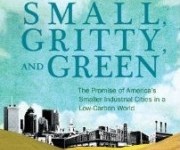Cross-posted from Urbanite.
A couple of years ago, while I was reporting on a redevelopment plan in Buffalo, N.Y., I met up with Robert Shibley, an architecture professor who had long been interested in a renaissance for his once-great Rust Belt town. Buffalo, along with cities like Utica, Syracuse, and Rochester, had the sort of wonderful, old architecture and infrastructure you can find across upstate New York. We agreed that it was a shame to watch these places crumble in abandonment.
But Shibley foresaw a glorious future. With ample freshwater (including the nearby Great Lakes), rich agricultural land, and a cool climate, upstate New York was well positioned in a hot, thirsty, and oil-starved future. It was almost a Manifest Destiny. “It is our ecological responsibility to grow here,” he said.
Catherine Tumber would have agreed. Her excellent new book, Small, Gritty, and Green: The Promise of America’s Smaller Industrial Cities in a Low-Carbon World, finds potential in many busted and booming-again cities in the Northeast and Midwest, cities like Flint, Mich.; Muncie, Ind.; Peoria, Ill.; and Youngstown, Ohio. She could have swept south and also included Hagerstown, Md.; York, Pa.; and maybe even Richmond, Va.; and Greensboro, N.C., and still stuck to her thesis. Even my hometown of Baltimore — which might be larger but has so far avoided unchecked sprawl — may fit into Tumber’s vision. These places, she writes, are both big enough and small enough to manage a coming societal transition, in which people may have to live on constrained oil supplies and rely more on local networks for food and other goods.
Tumber’s thinking goes against the grain of urban thinkers who contend that cities will organize themselves into giant “megaregions,” sprawling into one another, often along interstates. (In this future, my hometown would be one node in a megalopolis that includes New York, Philadelphia, and Washington, D.C.) Megaregion futurism has its champions among pundits and policymakers: Richard Florida shuns smaller cities in the hinterlands with his theory of the “creative class” — society’s Alphas, who allegedly seek out cosmopolitan cities. Barack Obama’s $50 billion high-speed rail plan — which, for hefty ticket prices, would connect megaregions like Miami-Tampa, San Francisco-San Diego, and the Northeast Corridor — likewise ignores smaller cities, which would benefit from investment in regular old rail.
The megaregion concept is a product of globalization, which values ruthless efficiency and specialization, with most of the benefits going to elites. But Tumber believes that globalization is a historical anomaly, not necessarily a new world order. “Globalization relies on cheap, long-distance transportation and industrial food production, both highly dependent on finite reserves of oil, whose bounty is already belied by spiking fuel prices and mounting alarm about climate change,” she writes. Or, as put by James Howard Kunstler, the peak-oil prophet (whom Tumber cites here and there in her book): “The world is about to become a larger place again.”
So how do these small cities, long derided as provincial and irrelevant, prepare for the future that Tumber sees coming? She focuses on several broad topics: controlling sprawl and redeveloping the suburban fringe, developing agriculture in and around the city, reviving small-scale manufacturing, and redesigning economic networks and school systems. All of these topics involve interlocking policy conundrums that may be more easily navigated in small cities, where relationships are closer and bureaucracy less entangling.
Two of Tumber’s six chapters are devoted to agriculture. And these sections of the book represent much of the way Tumber dissects her book’s topics: She makes an efficient survey of the history and current thinking around urban and suburban agriculture, but she focuses on places and colorful characters that illustrate the challenges, which mainly lie in policy changes.
In this section, it’s Henry Brockman, who owns a 24-acre farm in Illinois, 20 miles between Peoria and Normal. In what seems like a win for the globalist view, he sells his sustainably cultivated produce way up in the wealthy north-Chicago suburb of Evanston. Why doesn’t he sell in Peoria? Although the demand is there, the markets there allow vendors to buy vegetables wholesale and resell them, which drives away local growers. Policy changes informed by consumer demand could fix this, Tumber says. In fact, a relatively small number of farms like his could feed all of Illinois. And someday, they may need to: Most domestically produced food is shipped from California, but Tumber points out that 86 percent of California farmland is targeted for development — and it is threatened by the trends of climate change.
Baltimore, where I live, already has a vibrant farmers market network, and a number of groups are working on recultivating vacant parts of the city. Perhaps the biggest challenges here are the school systems, the reskilling of an industrial workforce, and the support of local businesses. The good news on that front, Tumber argues, is that localism, which started in the 1970s mainly as a countercultural movement, now represents a broader group of people who see globalism’s fragility and its attacks on small businesses.
Given the popularity of the Tea Party, which claims, at least, to look out for the little guy, localism could expand its reach even further. Tumber points to C. Wright Mills, a sociologist who, following World War II, concluded that small- to medium-sized cities were the best places for small-business entrepreneurs, and that because of that culture, these places in turn supported a more democratic environment, with people that supported civic enterprises like libraries and arts institutions. (By contrast, the corporatist, globalist track supported disinvestment.) The modern localist movement, Tumber writes, “is little understood and well worth recovering,” as it “could appeal to both liberals and conservatives during our own era of economic upheaval and political crisis.”



